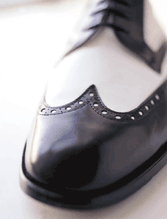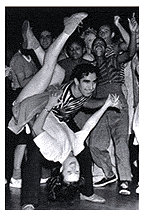|
If
The Shoe Fits: Two Tone Style
by Lesley Martin
Before
proceeding any further, Gentleman Reader, if you are wearing spectator
shoes right now and it is anytime before Memorial Day or after
Labor Day, take them off immediately. According to the same traditions
that frown on sporting a straw hat before June and gasp in dismay
at wearing white after early September, spectator shoes are strictly
a spring and summer shoe.
 |
| Photo
©Tara Sigori |
|
Not
sure what qualifies as a spectator shoe? The simplest
explanation: two-tone oxford shoes. There are plenty of
variations of two-tone styles—balmoral, bulcher, and saddle,
to name a few—each having to do with the assembly of the
shoe (how many pieces of leather, suede, or other materials
go into making it), and how each piece is cut and colored.
A spectator can also feature broguing, the perforations
that adorn a shoe along the stitching or as purely decorative
patterning on the toe. The most traditional style of spectator
shoe is assembled from pieces of black or brown leather
at the toe cap, back quarter, and instep, with white and
sometimes tan suede or buckskin at the front (also called
the vamp) and sides. This color scheme can also be reversed,
with the lighter pieces at the toes and back quarter,
and a saddle-shaped piece of contrasting, darker leather
at the front and sides, though technically speaking, the
latter are more correctly known as saddle oxfords.
Like
most fashion dictates of more rigid days, however—days when men
wouldn’t dream of wearing a hat indoors and women wouldn’t be
caught dead with their lingerie showing—these seasonal restrictions
seems to have fallen by the wayside. Today, catch a man walking
down the street in two tone shoes, regardless of season, and people
generally think, “Oh, swing.” In the last ten years, the two-tone
spectator shoe has become inextricably connected with swing and
swing dancers. There are a few obvious reasons why this would
be so—after all, the fashion for two-tone shoes hit its peak during
the 1920s and ’30s, a time when swing music and the large dance
bands were reaching their heyday. “This season, more two-tone
oxfords than ever before are being sold,” reads the copy for a
snappy pair of spectator shoes in the 1928/1929 Sears, Roebuck,
and Co. catalog, before insisting that they are a necessary part
of the well-dressed male’s casual or sports wear.
Nevertheless,
the history of the two-tone shoe reaches back into the late 1800s,
when the properly dressed gentleman was never without spats or
gaiters to protect the wearer’s calves and ankles from the daily
grime of the street. One theory, according to Laird Borrelli,
fashion writer for Vogue.com and co-curator of Shoes: A Lexicon
of Style, is that the contrasting look of white spats against
the leather shoes and dark trouser cuff became incorporated into
the shoe itself. On a more utilitarian note, says New York-based
fashion stylist and retro-clothing enthusiast Chad Kincaid, darker
tones on the toe caps and backs of the shoes would protect the
wearer’s shoes from grass stains—specifically grass stains that
a spectator at the races or a golfer might otherwise expect to
incur if wearing the white summer dress shoes fashionable in the
first-part of the 1900s.
This
sporty aesthetic is one connotation of the spectator shoe; the
well-turned out male of the Prohibition Era was all about sleek,
art-deco lines and jaunty, stylized casual wear, as popularized
by Prince Edward of Wales. The Prince of Wales, who wore spectators
while golfing, was internationally revered as a man of style.
His fashion choices, according to Farid Cheneoure in A History
of Men’s Fashion, were quickly emulated by rich kids on the
campuses of Ivy League schools throughout the United States.
Back
in England, this two-tone style was called the co-respondent.
Elizabeth Semmelhack, Curator of the Bata Shoe Museum in Toronto,
tells us that a co-respondent in a divorce case is the man who
has committed adultery with one’s wife—“a swinger, so to speak”—yet
another association well-suited to the flash and daring of the
hot jazz era (think Gatsby, think Moveable Feast).
A gentleman rake could count on adding a snap in his step with
a pair of flashy two-tones.
In
flipping through photos of the ’20s and ’30s, the two-tone is
in wide evidence. Hollywood stars wore them: Rudy Vallee, Louis
Armstrong…the entire Ted Weems Orchestra was outfitted with them
in the 1920s, as well as the Harry James Orchestra in the late
1930s. Frank Sinatra and Count Basie had a pair or two. The burgeoning
gangster culture of the ’30s appropriated the brash showiness
of a spiffily shined two-tone shoe to their wardrobe.
 |
|
Photo
© FPG Intl., LLC
|
|
Yet
although Fred Astaire glamorized the style in countless films, you
don’t see two-tones on the feet of many Lindy Hop dancers in archival
footage or photographs—possibly because they were mostly made with
the leather soles too stiff to be comfortable for dancing. Yet the
association persists, in large part because of a general popular
image of swing that has developed as part of the recent neo-swing
movement. In the early days of the swing revival—the late 1980s
and early 1990s—the crowds consisted of equal parts swing and jump-blues
music fans, dance fans, and retro-clothing aficionados who appreciated
the bombastic gangster ethos of the ’30s mixed with the urbane cool
of the spectator-clad Edwardian.
Examine
the CD covers of albums from such bands as the Cherry Poppin’
Daddies, Big Bad Voodoo Daddy, and the Blues Jumpers, and more
than just a few of the musicians are wearing vintage shoes, or
contemporary updates of the look. The redux association of hot
jazz or swing and two-tone shoes has even been picked up by the
most classic of American shoe makers. Johnston & Murphy, a
top-end shoe manufacturer founded in 1850 and a sponsor of the
Lincoln Center Jazz Orchestra, adopted LCJO artistic director
Wynton Marsalis as their model in recent promotional pieces.
The
Spring 1999 catalog for Allen-Edmonds, another venerable shoe-manufacturer
dating from 1922, enlists the memory of Duke Ellington in promoting
their 1999 Spring Season spectatored wing-tip. The Stacy Adams
web page informs us that “finding the right shoes it just the
first step,” and asks us to check out their links to find “the
music, apparel, news and reviews that complete your look and entire
lifestyle.” The featured links range from neo-swing bands to sites
like AnySwingGoes.com and Zootsuitstore.com, to magazines like
Vibe and The Source.
Ruth
Rubinstein, in her book, Dress Codes: Meanings and Messages
in American Culture, defines the idea of “clothing speech,”
or the signals that one’s manner of dress sends out to the people
around you. The two tone shoe is a sure fire semaphore for style.
It draws the eye and smacks of carefully cultivated dress choices.
With a smorgasbord of styles to choose from in the early 21st
century, two-tone spectators may be the shoe for you; just don’t
let the International Fashion Police catch you wearing them out
of season.
Related
Links:
http://www.allenedmonds.com
http://www.stacyadams.com
http://www.johnstonandmurphy.com
http://www.florsheim.com
http://www.zappos.com
This
story first appeared in the Fall 2000 issue of ATOMIC Magazine.
|










